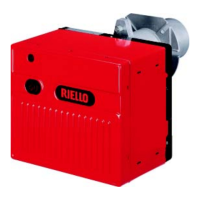
Do you have a question about the Riello 40 FS8 and is the answer not in the manual?
Declaration of conformity in accordance with ISO/IEC 17050-1, listing applicable standards and directives.
Details on the instruction manual's purpose, symbols, and importance for safe operation.
Explanation of danger levels, safety symbols, and warnings for potential hazards.
Manufacturer's warranty terms, responsibilities, and conditions that may void the guarantee.
Introduction to safety principles and potential dangers associated with burner operation.
Guidelines for user and personnel training, emphasizing qualified personnel and safety awareness.
Explanation of the burner's designation system, including range, fuel, size, and variations.
List of available burner models with their designations, voltage, and codes.
Categorization of burners based on country of destination and gas category.
Detailed technical specifications including heat output, fuel, operation, electrical supply, and noise levels.
Maximum dimensions of the burner and its flange, illustrated with diagrams.
Information on burner output selection using a diagram, and conditions for firing rate determination.
Graph showing the relationship between gas pressure at the combustion head and thermal power output.
Detailed diagram and description of the burner's main components and their functions.
List of standard equipment and parts included with the burner.
Information on the electrical control box, including warnings, installation notes, and electrical characteristics.
Critical safety instructions to be followed before and during the installation process.
Guidelines to prevent burner burnout and ensure proper combustion, including installation environment.
Instructions for safe handling, storage, and disposal of packaging materials.
Essential checks to perform before proceeding with the burner installation.
Defines the acceptable installation orientations for the burner and prohibits unsafe positions.
Instructions on how to securely attach the burner to the boiler, including hinge installation.
Guidance on the correct positioning of the ignition electrode and ionisation probe to prevent damage.
Procedure for adjusting the combustion head for optimal air pressure and output.
Instructions for installing the gas feeding line and gas train, including safety warnings.
Step-by-step guide for installing the gas train, including electrical connections and leak checks.
Safety notes and procedures for electrical wiring, including control box connections and precautions.
Detailed electrical diagram of the burner and control box, with a key to components.
Information on ionisation current requirements and how to measure it for diagnostics.
Essential safety guidelines for qualified personnel performing the initial start-up of the burner.
Steps to perform before ignition, including head adjustment, air damper, gas line purging, and pressure switch setting.
Procedure for adjusting combustion parameters (CO2, CO, NOx) according to efficiency directives.
Detailed instructions for adjusting the air pressure switch to ensure proper air flow and prevent lockouts.
Detailed breakdown of the burner's operational sequence, including timing and component states.
Description of the lockout condition caused by ignition failure and its sequence diagram.
Explanation of lockouts resulting from flame detection before or during the pre-purging phase.
Table detailing various lockout causes, their descriptions, and triggering times.
Methods for resetting the control box, including using the built-in button and remote connection.
Explanation of the burner's recycle function for flame loss and its attempt limits.
Description of how the control box logs operating parameters like lockouts and operating times.
Details on programmable functions like post-purging and continuous purging, and how to set them.
Guide to interpreting LED signals for diagnosing control box malfunctions and errors.
Essential safety procedures to follow before, during, and after maintenance operations.
Recommended maintenance schedule and checks for the burner, boiler, gas train, and electrodes.
Procedure for safely opening the burner to access internal components for maintenance or repair.
Table of common start-up issues, their possible causes, and recommended solutions.
Table of common operating faults, their possible causes, and recommended solutions.
List of optional accessories and kits available for the burner, with their respective codes.